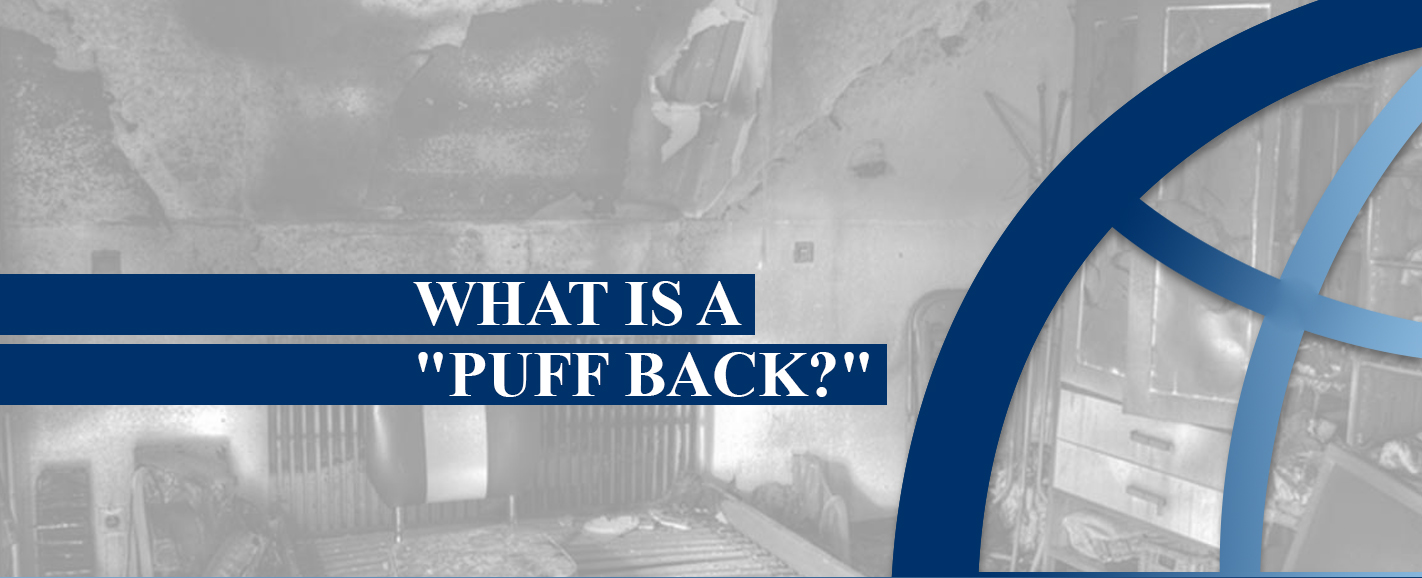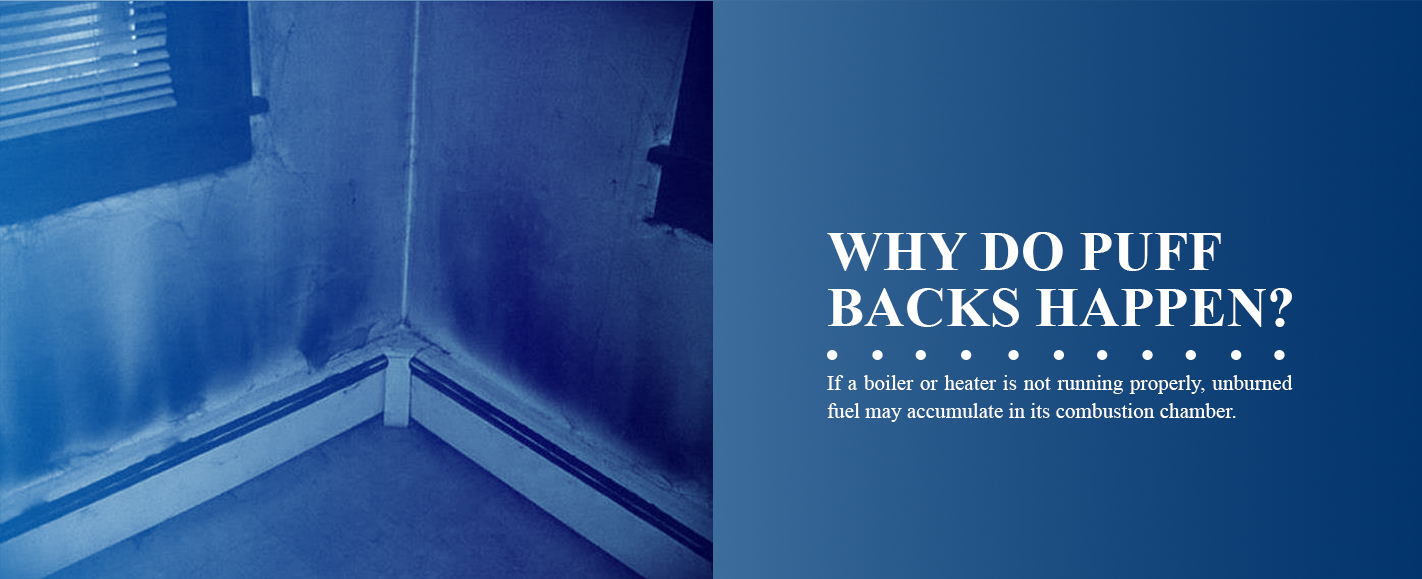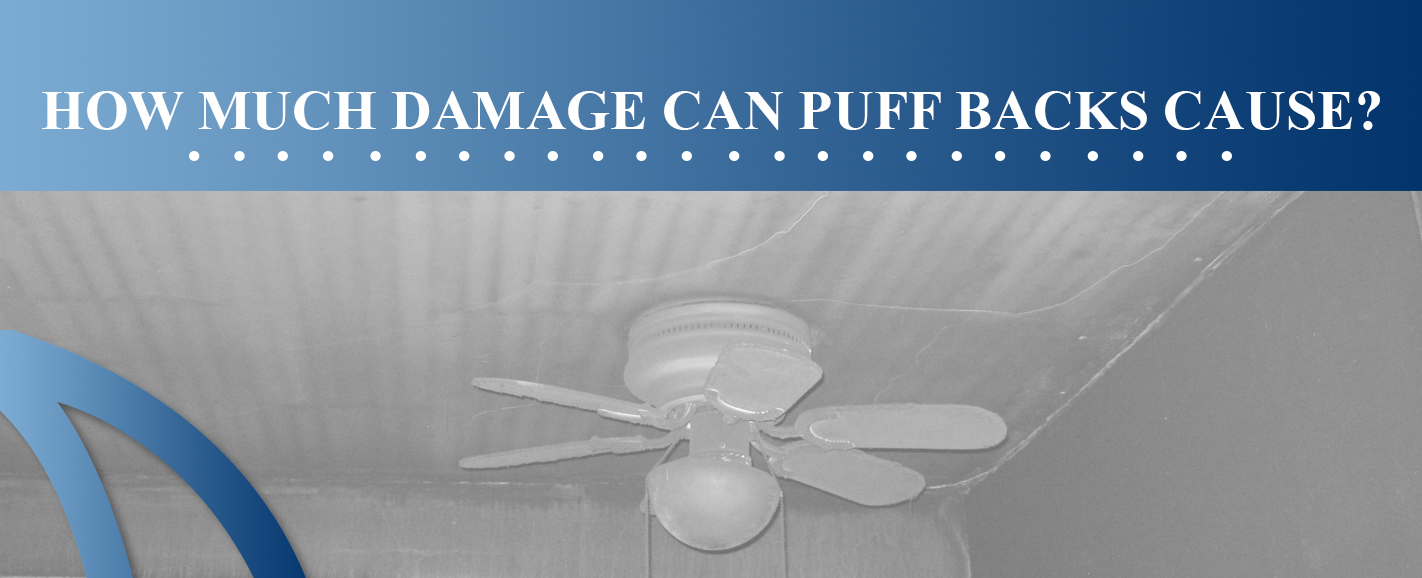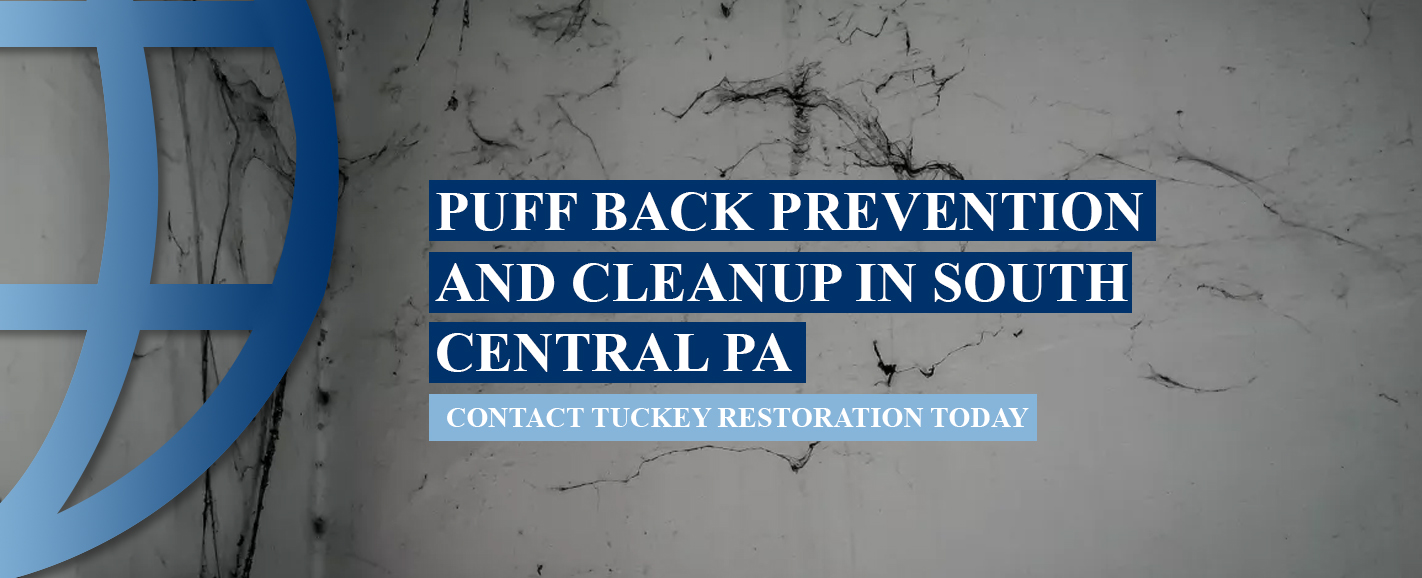What Is a “Puff Back?”
January 7, 2019 | 6:45 pm
In This Article:
- Why Do Puff Backs Happen?
- How Much Damage Can Puff Backs Cause?
- What Causes a Puff Back?
- What Should You Do When a Puff Back Happens?
- How Are Puff Backs Prevented?
- How do you clean up after a puff back?
With regular maintenance and inspections, your heating system can run smoothly all season long. But if a heating system is clogged, poorly ventilated or not functioning correctly, you may experience a messy and dangerous puff back when you start up your furnace this winter.
A puff back occurs when your oil burner backfires and shoots smoke and soot into your home or business. Puff backs can cause anything from minor inconvenience to severe damage to your property and heating system. Luckily, puff backs are preventable with proper heating system maintenance and by recognizing the warning signs early.
Read on for everything you need to know about what causes puff backs and how you can prevent them in your home or business.
Why Do Puff Backs Happen?
If a boiler or heater is not running properly, unburned fuel may accumulate in its combustion chamber. Upon starting the heating appliance, this oil can ignite and cause an explosion or misfire inside the furnace. This oil burner backfire, called a “puff back,” forces soot or smoke through the heating exhaust system and into the owner’s property. A puff back may be an explosion that releases a large amount of soot into the building, or it can occur in small instances each time a furnace or boiler gets ignited. Smaller chronic puff backs cause soot to accumulate in vents and on ceilings, baseboards or carpets.
Puff backs can occur in oil or gas furnaces, boilers or water heaters. Puff backs are more likely in oil-fired heating appliances than gas-fired because oil does not dissipate as easily. Oil-fired heating appliances also require more frequent maintenance, and improper maintenance can lead to ignition problems that cause a puff back. Oil puff backs are often more damaging than gas puff backs because oil creates more soot than gas.
Puff backs can be very damaging to the building and its contents, as well as to the heating system itself. Puff backs can spray soot throughout the building and can cause the furnace’s stack pipe to disconnect. Damage from puff backs can be expensive to fix and may not be covered by insurance, making puff back prevention essential.
How Much Damage Can Puff Backs Cause?
The severity of a puff back depends on the type of heater, how much fuel gets ignited in the combustion chamber and what caused the puff back to occur. A minor puff back may only release a small amount of soot, while a severe puff back can release soot throughout your entire home or business and cause damage to heater components. Other factors determine how far soot can spread after it gets expelled from the heater or boiler, including:
- The connection between the heater and the building
- The structure and layout of the building
- The routing of the HVAC ducts
- Open and closed doors in the building
A puff back that occurs in a forced-air heating system is typically the most damaging, as the extensive ductwork allows soot to travel to the entire house. Because forced air systems are designed to effectively push hot air to every room of your home, during a puff back, such systems transport soot and smoke just as effectively. When a puff back occurs in a forced-air heating system, it can even release soot into closets and rooms with closed doors. If a puff back happens in a water-based heating system, on the other hand, less soot is likely to be released and it may not spread as far.
Soot from a puff back can cover walls, ceilings, cabinets, carpets, furniture, bedding, drapes and everything else in your home or business in a thin film. Smoky streaks can occur on walls, and fabric materials can become black and sticky. Because the soot from a puff back is mixed with oil, it can also be very challenging to clean. Severe puff backs may result in significant property losses and could even force you out of your home.
If a puff back causes damage to the heating system as well, repairs will be even more costly. A forceful puff back can cause the heating flue vent connector to burst or can damage the boiler itself. If a flue vent connector becomes dislodged, you are also at risk of fire as combustion gases and sparks may get released into the building. A broken flue vent could also allow dangerous carbon monoxide to leak into the building.
Repairs and restoration following a puff back can be extensive and costly, depending on the damage. Home and business owners should take precautions to prevent puff backs and avoid damage to their home or business, belongings and heating system.
What Causes Puff Backs?
Puff backs occur during ignition of a heater, furnace or boiler due to fuel accumulation in the combustion chamber of the heating appliance. This accumulation of unburned oil at the end of an on-off cycle can be the result of a variety of problems. Here are the most common reasons oil accumulation leading to a puff back may occur:
1. Leaks in the Oil Supply Piping
A leak in the oil supply piping can allow air to enter the heating appliance when the burner is running. Air bubbles in the heating oil will be under high pressure when the appliance is running, but after the furnace or burner shuts off, the pressure inside the system drops and the air bubble expands. The expanding air bubbles can force unburned heating oil through the oil burner nozzle and into the combustion chamber. The unburned oil accumulates inside the combustion chamber through several on-off cycles and can lead to a dramatic puff back.
When the heater or furnace is not running, these holes in the oil supply piping may be visible as oil leaks. If a homeowner or heating service technician notices a small oil drip near the combustion chamber, they should address it immediately before a puff back occurs.
2. Heater Shutdown Problems
When a furnace or boiler shuts down, the flow of oil into the oil burner nozzle should cease immediately. In a properly functioning heating system, a valve inside the appliance securely stops oil flow when the motor stops during shutdown. However, if this valve is not working correctly due to a malfunction causing it to stick or dirt preventing the valve from closing properly, oil can continue to leak into the combustion chamber.
3. Clogged or Damaged Oil Spray Nozzle
For a heater or furnace to function correctly, fuel must be able to flow freely through the entire system. Any clogged or dirty component may prevent the furnace from burning all the fuel in the combustion chamber and result in oil accumulation. One common problem area is the oil spray nozzle. If the oil spray nozzle is clogged or cracked, it may not be able to spray oil evenly into the combustion chamber to allow proper ignition. When starting the heating appliance, the oil spray nozzle will continue to attempt to spray oil, which can collect inside the burner. A damaged oil spray nozzle may also produce an insufficient flame that leads to unburned oil. When the fuel finally ignites, this accumulation of excess oil can lead to a puff back.
4. Issues With Chimney or Heater Installation
In some instances, a puff back results from underlying installation problems, rather than poor maintenance or a faulty heating appliance. If a chimney is too short, it may not allow enough draft for the heater to function efficiently. The burner may produce more soot and smoke that can clog the burner ignition. That may lead to chronic puff backs that release small amounts of soot and smoke each time the heating appliance starts up. A more severe puff back may occur as the heater operates poorly over time and creates unburned oil inside the system.
A professional heating technician should be able to recognize issues in chimney or heater installation during a regular inspection, though this may not always be reasonably possible due to several factors. It may require structural alterations to prevent a puff back from occurring.
5. Problems With Combustion Gas Venting
In a clean and properly functioning heating appliance, combustion gases must be able to vent out of the system during operation. If combustion gases cannot escape from the furnace, it creates an imbalance of air and fuel inside the combustion chamber. This imbalance may cause a flame roll-out, in which flames inside the combustion chamber spread to other furnace components. A flame roll-out can damage other furnace parts and also creates a fire risk, as well as resulting in an improper combustion process. Poor combustion due to a flame roll-out can cause fuel to accumulate in the combustion chamber.
Flame roll-outs can result from a variety of furnace operation problems that prevent combustion gases from venting adequately, including a clogged chimney or exhaust or a cracked heat exchanger.
What Should You Do When a Puff Back Happens?
When a puff back occurs, it can cause devastating effects inside the building and may damage the heating system itself. Immediately after a puff back occurs, shut off the heating system to prevent further damage. If there is a risk of fire or a large amount of smoke, evacuate the building. If your carbon monoxide detector goes off, evacuate and call emergency services. Once the building is safe, here are a few other steps home and business owners should take after a puff back occurs.
- Document the incident: If you plan to report the incident to your insurance company, take pictures of the damage immediately after the puff back occurs (assuming it’s safe to do so). Home and business owners should photograph damage to the heating system and soot coverage in the building.
- Contact a heating repair service: Contact a heating repair technician to inspect the heating system before turning it back on. The repair technician can assess the safety of the heating system and identify the underlying problem that caused the puff back. The heating repair service will be able to determine what repairs may be necessary and correct any problems to prevent future puff backs.
- Contact a cleaning service: While it may be tempting to begin cleaning the soot immediately after the puff back occurs, hasty cleaning may only cause more damage. Because soot from a puff back also contains oil, improper cleaning may smear soot into walls and furniture. Puff backs can also produce a foul odor you may not be able to eradicate on your own. After a puff back, hire a professional cleaning service to properly remove soot and chemicals.
- Clean and dispose of soiled belongings: You may be able to clean clothing, drapes and other fabric materials on your own or take them for dry cleaning. Vacuum loose soot and debris from the carpets and furniture, and immediately dispose of any food that has been exposed to soot or smoke.
How Are Puff Backs Prevented?
By taking the right precautions and noticing the warning signs, you can prevent puff backs that cause extensive damage to your property and belongings. Home or business owners with oil or gas boilers, furnaces or water heaters should be able to recognize when their heating system is not functioning properly so they can contact a repair service before the situation escalates and causes a puff back. Here are a few ways that homeowners can prevent puff backs:
1. Know the Warning Signs of a Puff Back
One of the most effective ways to avoid a puff back is to catch a problem with your heating system before it is too severe. In most instances, the heating appliance will show many signs that it is not working correctly before a puff back occurs. Here are some warning signs that a puff back may happen in your heating system.
- Oil leaks: Visible oil drips around the oil supply piping are a telltale warning sign that a puff back may be imminent. Drips may occur at connectors or fittings along the piping and allow air to enter the system while it is running.
- Loud startup: A small “bang” or “puff” sound upon starting your heating unit may indicate small amounts of unburned oil are igniting in the combustion chamber. If you fail to address these small puff backs, it could lead to a more serious puff back in the future.
- Noise after shutoff: A rumbling or vibrating sound that continues after you shut off the boiler may be a sign that oil is leaking into the combustion chamber.
- Sooty operation: If you notice soot in the furnace room, on walls or ceilings of your home or on top of the heating appliance, this may be a sign that your furnace is not operating properly.
- Strange odors: A furnace that is not working correctly may produce a strong smell that signifies the combustion gases are not venting properly, which can cause a puff back.
2. Address Problems Immediately
If you notice any of the warning signs of a puff back, you should contact a heating repair service immediately. While these warning signs may not lead to a puff back, it’s beneficial to have an HVAC professional inspect your heating system and identify the cause of the problem. An experienced repair technician will be able to fix any issues that could lead to a puff back or damage your heating system in other ways. Because puff backs can result from a wide variety of problems with boiler or furnace operation, it is best not to try to diagnose or fix it yourself.
3. Have Your Heating System Serviced Regularly
Even if your boiler, furnace and water heater appear to be functioning correctly, preventive HVAC maintenance will keep your heating system in good condition. Regular servicing of your heating system will include cleaning to remove soot that builds up naturally during a heating season. It prevents excessive soot buildup from impeding ventilation or blocking air flow which can indirectly cause a puff back. Preventive maintenance should also include changing your oil spray nozzle if it is clogged or dirty and checking that all heating components are in good working order. A professional heater repair technician will also be able to notice warning signs of a puff back you may have missed.
How Can a Restoration Contractor Help After a Puff Back?
After a puff back occurs, homeowners should contact a professional service to clean their home and belongings, as well as to assess the damage and repair their heating system. A restoration contractor can effectively provide all these services to help homeowners recover from a puff back. Here are four ways a restoration contractor can help after a puff back occurs in your home.
Provide professional cleaning services: How do you clean up after a puff back?
A restoration contractor can effectively clean and deodorize your home and belongings through professional cleaning services. A restoration contractor will have the right tools, materials and techniques to remove soot and smoke marks from your home by tackling the problem at the source. Many over-the-counter cleaning supplies may only be able to mask the effects of a puff back, rather than effectively removing all soot and smoke streaks. A restoration contractor may also be able to apply chemical cleaning techniques to your carpets, furniture or drapes to remove soot that has absorbed into the fabric.
Assess the damage to your heating system
Working in conjunction with a mechanical contractor, a professional restoration service will be able to safely inspect your combustion chamber and other heating system components to identify any damage the puff back has caused to your furnace, boiler or water heater.
Determine the cause of the puff back
After a puff back occurs, correctly identifying the problem can protect against future puff backs or further damage to your heating system. A restoration contractor will be able to engage a qualified mechanical contractor to check the entire heating system to identify problem areas and the cause of the puff back.
Repair or replace your heating system
After identifying the problem, a restoration contractor will be able to engage a qualified mechanical contractor to efficiently and effectively repair your heating system. A fast and complete repair allows you to recover from a damaging puff back more quickly and reduce your losses and expenses. The great thing about Tuckey Restoration? Our sister company, Tuckey Mechanical Services, can offer the in-house expertise necessary to complete this whole process – without asking the homeowner to contact multiple contractors.
Puff Back Prevention and Cleanup in South Central PA
If you suspect your furnace, boiler or water heater is not working correctly, contact a repair service before a damaging puff back occurs. At Tuckey Mechanical Services, Inc., we offer inspection and repair services for all HVAC systems, including oil furnaces, gas furnaces, boilers and water heaters. Our professional repair technicians will be able to quickly identify and repair any problems with the heating system in your home or business. If your heating system requires a replacement, Tuckey Mechanical offers a variety of high-quality furnaces, boilers and water heaters to suit your needs. And if a puff-back does occur, Tuckey Restoration, Inc. can professionally clean soot and odors from your home.
Tuckey Restoration also offers 24-hour emergency care for all our customers in the South Central PA area. If you need immediate assistance for a severe puff back in your home or business, our professional staff is always on-hand and ready to jump in. For puff back service in Carlisle, Chambersburg, Harrisburg, Shippensburg or York, PA, contact Tuckey Restoration today.
All material Copyrighted (c) by the Tuckey Companies, 2025.





